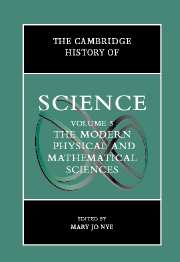Book contents
- Frontmatter
- Introduction: The Modern Physical and Mathematical Sciences
- Part I The Public Cultures of the Physical Sciences After 1800
- Part II Discipline Building in the Sciences: Places, Instruments, Communication
- Part III Chemistry and Physics: Problems Through the Early 1900s
- Part IV Atomic and Molecular Sciences in the Twentieth Century
- Part V Mathematics, Astronomy, and Cosmology Since the Eighteenth Century
- 23 The Geometrical Tradition: Mathematics, Space, and Reason in the Nineteenth Century
- 24 Between Rigor and Applications: Developments in the Concept of Function in Mathematical Analysis
- 25 Statistics and Physical Theories
- 26 Solar Science and Astrophysics
- 27 Cosmologies and Cosmogonies of Space and Time
- 28 The Physics and Chemistry of the Earth
- Part VI Problems and Promises at the End of the Twentieth Century
- Index
- References
28 - The Physics and Chemistry of the Earth
from Part V - Mathematics, Astronomy, and Cosmology Since the Eighteenth Century
Published online by Cambridge University Press: 28 March 2008
- Frontmatter
- Introduction: The Modern Physical and Mathematical Sciences
- Part I The Public Cultures of the Physical Sciences After 1800
- Part II Discipline Building in the Sciences: Places, Instruments, Communication
- Part III Chemistry and Physics: Problems Through the Early 1900s
- Part IV Atomic and Molecular Sciences in the Twentieth Century
- Part V Mathematics, Astronomy, and Cosmology Since the Eighteenth Century
- 23 The Geometrical Tradition: Mathematics, Space, and Reason in the Nineteenth Century
- 24 Between Rigor and Applications: Developments in the Concept of Function in Mathematical Analysis
- 25 Statistics and Physical Theories
- 26 Solar Science and Astrophysics
- 27 Cosmologies and Cosmogonies of Space and Time
- 28 The Physics and Chemistry of the Earth
- Part VI Problems and Promises at the End of the Twentieth Century
- Index
- References
Summary
Throughout the late eighteenth and nineteenth centuries, there were two distinctly different ways of thinking about the earth – two different evidentiary and epistemic traditions. Such men as Comte Georges de Buffon and Léonce Elie de Beaumont in France, William Hopkins and William Thomson (Lord Kelvin) in the United Kingdom, and James Dwight Dana in the United States tried to understand the history of the earth primarily in terms of the laws of physics and chemistry. Their science was mathematical and deductive, and it was closely aligned with physics, astronomy, mathematics, and, later, chemistry. With some exceptions, they spent little time in the field; to the degree that they made empirical observations, they were likely to be indoors rather than out. In hindsight, this work has come to be known as the geophysical tradition. In contrast, such men as Abraham Gottlob Werner in Germany, Georges Cuvier in France, and Charles Lyell in England tried to elucidate earth history primarily from physical evidence contained in the rock record. Their science was observational and inductive, and it was, to a far greater degree than that of their counterparts, intellectually and institutionally autonomous from physics and chemistry. With some exceptions, they spent little time in the laboratory or at the blackboard; the rock record was to be found outside. By the early nineteenth century, students of the rock record called themselves geologists. These two traditions – geophysical and geological – together defined the agenda for what would become the modern earth sciences. Geophysicists and geologists addressed themselves to common questions, such as the age and internal structure of the earth, the differentiation of continents and oceans, the formation of mountain belts, and the history of the earth’s climate.
- Type
- Chapter
- Information
- The Cambridge History of Science , pp. 538 - 558Publisher: Cambridge University PressPrint publication year: 2002
References
- 2
- Cited by



